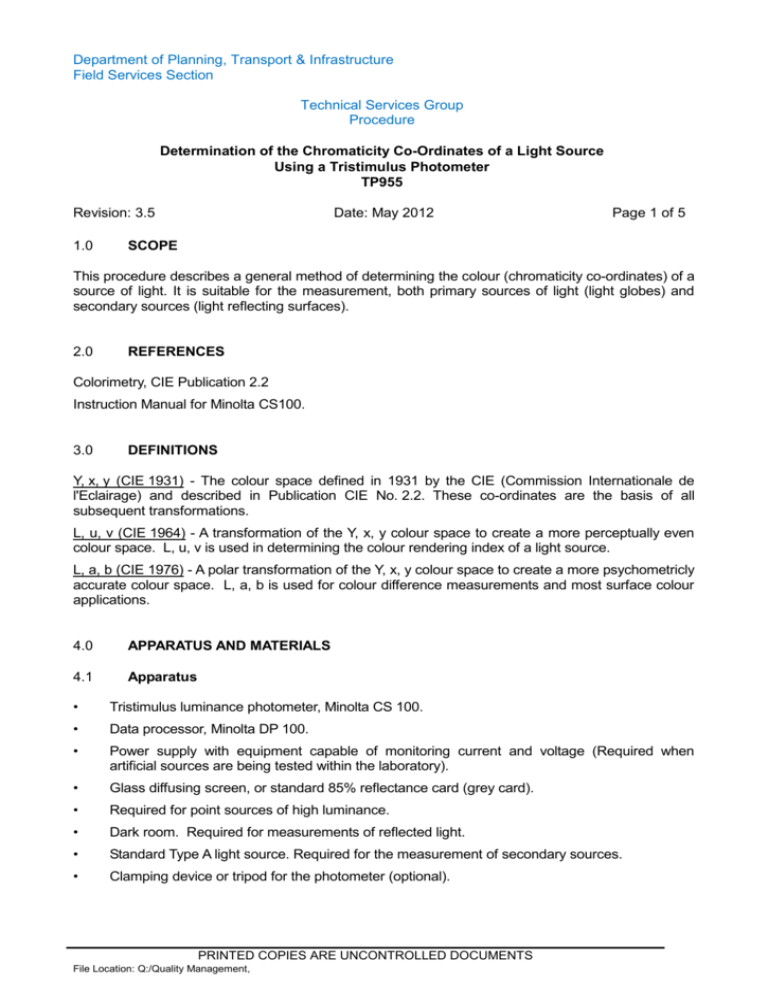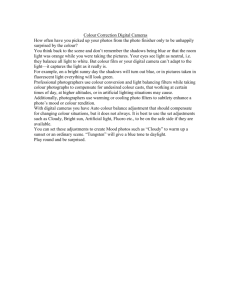TP955 - Department of Planning, Transport and Infrastructure
advertisement

Department of Planning, Transport & Infrastructure Field Services Section Technical Services Group Procedure Determination of the Chromaticity Co-Ordinates of a Light Source Using a Tristimulus Photometer TP955 Revision: 3.5 1.0 Date: May 2012 Page 1 of 5 SCOPE This procedure describes a general method of determining the colour (chromaticity co-ordinates) of a source of light. It is suitable for the measurement, both primary sources of light (light globes) and secondary sources (light reflecting surfaces). 2.0 REFERENCES Colorimetry, CIE Publication 2.2 Instruction Manual for Minolta CS100. 3.0 DEFINITIONS Y, x, y (CIE 1931) - The colour space defined in 1931 by the CIE (Commission Internationale de l'Eclairage) and described in Publication CIE No. 2.2. These co-ordinates are the basis of all subsequent transformations. L, u, v (CIE 1964) - A transformation of the Y, x, y colour space to create a more perceptually even colour space. L, u, v is used in determining the colour rendering index of a light source. L, a, b (CIE 1976) - A polar transformation of the Y, x, y colour space to create a more psychometricly accurate colour space. L, a, b is used for colour difference measurements and most surface colour applications. 4.0 APPARATUS AND MATERIALS 4.1 Apparatus • Tristimulus luminance photometer, Minolta CS 100. • Data processor, Minolta DP 100. • Power supply with equipment capable of monitoring current and voltage (Required when artificial sources are being tested within the laboratory). • Glass diffusing screen, or standard 85% reflectance card (grey card). • Required for point sources of high luminance. • Dark room. Required for measurements of reflected light. • Standard Type A light source. Required for the measurement of secondary sources. • Clamping device or tripod for the photometer (optional). PRINTED COPIES ARE UNCONTROLLED DOCUMENTS File Location: Q:/Quality Management, Department of Planning, Transport & Infrastructure Field Services Section Technical Services Group Procedure Determination of the Chromaticity Co-Ordinates of a Light Source Using a Tristimulus Photometer TP955 Revision: 3.5 4.2 Date: May 2012 Page 2 of 5 Materials Nil. 5.0 SAMPLING AND SAMPLE PREPARATION 5.1 Sampling Nil. 5.2 Sample Preparation New lamp may require conditioning as per manufacturer's recommendation, to provide a stable output. 6.0 PROCEDURE TO BE FOLLOWED Note: The operator shall read the meter and data processor manuals before operating them. 6.1 Using the cord supplied, connect the meter to the DP100 data processor. Note: The meter can be used without the data processor if only rough readings of the Y, x, y co-ordinates are required. 6.2 Switch on both the data processor and the meter. Note: If the meter battery is low, the meter display will show `b0' and if the data processor batteries are low the display will not show `initial set OK'. 6.3 Ensure the calibration switch on the meter is set to `preset' and the measuring mode is set to `abs'. 6.4 Set the colour space on the data processor to that required for the set of readings as listed in Table 1. PRINTED COPIES ARE UNCONTROLLED DOCUMENTS File Location: Q:/Quality Management, Department of Planning, Transport & Infrastructure Field Services Section Technical Services Group Procedure Determination of the Chromaticity Co-Ordinates of a Light Source Using a Tristimulus Photometer TP955 Revision: 3.5 Date: May 2012 Page 3 of 5 Table 1 Colour Spaces for Various Types of Measurement Colour Rendering Primary Source Colour Difference Primary Source General Colour Measurement Secondary Source Colour Measurement Secondary Source Colour Difference Measurement 6.5 Preferred L, u, v L, u, v Alternative Y, x , y Y, x, y L, u, v Y, x, y L, a, b L, a, b Y, x, y Ensure source to be measured is at least 1.1 m from the meter and that the measuring spot is completely filled by the source to be measured. If the source to be measured is a secondary or light reflecting surface, the meter shall be placed at the specified angle to the normal of the surface plane. Note 1: The angle specified will generally be either 45o or 0o. Note 2: It is of advantage to use a mounting device such as a tripod or clamping device to hold the meter steady. 6.6 If the source is a primary point source of high luminance, either a glass diffusing screen shall be interposed between the source and the meter, or the source shall be directed at a Kodak 85% reflectance grey card and the source shall be measured indirectly. Note: The use of a glass plate gives more accurate measurements but is often impracticable. If the grey card is used, it shall be placed normal to the incident light and measurements shall be made with the meter at an angle of 45o to the card. 6.7 Focus the meter on the source. If a diffusing screen has been interposed, the screen is now effectively the source. If a reflectance card is in use, the source is the reflectance card. 6.8 Where the source is to be used under controlled electrical conditions (such as the laboratory determination of the colour of vehicle lighting), the current and voltage shall be monitored. This shall require the use of a stabilised power supply. 6.9 Reflected colour readings require the exclusion of stray light. In the laboratory, readings shall be made in a dark room. Reflected light readings also require the use of a primary source of known characteristics. Unless otherwise specified, the laboratory standard CIE Type A light source shall be used. This shall be set up as per Clause 6.8. PRINTED COPIES ARE UNCONTROLLED DOCUMENTS File Location: Q:/Quality Management, Department of Planning, Transport & Infrastructure Field Services Section Technical Services Group Procedure Determination of the Chromaticity Co-Ordinates of a Light Source Using a Tristimulus Photometer TP955 Revision: 3.5 Date: May 2012 Page 4 of 5 6.10 The measure switch on the data processor (when connected) or the measuring trigger of the meter (when the data processor is not in operation) shall be depressed. 6.11 The colour co-ordinates shall be recorded. The data processor has a facility for printing on thermal paper, however, this printout has limited permanency and results must be recorded separately. Note: The colour co-ordinates are computed within the instrument, thus no calculation is required. 6.12 Where measurements are made in the Y, x, y colour space, the results shall be plotted on a chromaticity diagram. If the co-ordinates fall outside the spectrum locus the test must be repeated as the results are invalid. If the results continue to fall outside the spectrum locus, colour determinations shall be made with a spectroradiometer. Note: Some highly saturated sources have insufficient intensity in some areas of the spectral curve to be recorded by all three of the tristimulus sensors of the instrument. This leads to a division by zero in the calculation and produces colour co-ordinates outside the allowable colour space. 6.13 For greater accuracy, a number of readings can be taken and averaged by the instrument. This option shall be used where colour within a solid angle is required to be determined. 7.0 CALCULATIONS Nil. 8.0 PRECISION The uncertainty of measurement has been determined as + x.x of the test result, at a confidence limit of 95% with a nominal coverage factor of 2, when calculated in accordance with the accreditation requirements as detailed in AS/ISO 17025. 9.0 REPORTS AND DOCUMENTATION 9.1 Reports 9.1.1 The trichromatic colour co-ordinates shall be reported. 9.1.2 The conditions of test and instrument used shall be reported. 9.1.3 Where controlled, the electrical conditions of test shall be reported. 9.1.4 Where secondary sources are measured, the geometry of test and characteristics of the primary illuminating source shall be reported. 9.2 Documentation PRINTED COPIES ARE UNCONTROLLED DOCUMENTS File Location: Q:/Quality Management, Department of Planning, Transport & Infrastructure Field Services Section Technical Services Group Procedure Determination of the Chromaticity Co-Ordinates of a Light Source Using a Tristimulus Photometer TP955 Revision: 3.5 Nil. Date: May 2012 PRINTED COPIES ARE UNCONTROLLED DOCUMENTS File Location: Q:/Quality Management, Page 5 of 5






